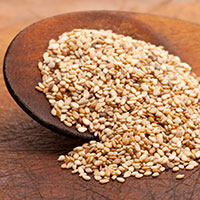| Mineral name |
Calcium |
| What’s it used for? | Growth and development of bones and teeth, regulating the heartbeat and blood pressure, important in nerve communication and blood clotting. |
| Best food sources | Milk and milk products, including yoghurt, butter and cheese. Green leafy vegetables and fish with bones such as sardines and pilchards |
| How much do I need? | NRV is 800 mg per day* |
| Need to know | Calcium works very closely with vitamin D and magnesium in all its functions |
*A Nutrient Reference Value or NRV is the recommended level set by the UK Department of Health for daily nutrient intake
Calcium
Calcium is the most abundant mineral in the body and, therefore, one of the most important. Calcium has some really vital life-supporting functions, the most crucial being the growth and development of bones and teeth; bones contain more than 99% of the body’s calcium. Sufficient intake is particularly important during infancy and childhood when a strong bone structure is being built.
Why do I need it?
As well as building strong bones and teeth, calcium is important in much of the body’s enzyme activity. The contraction of muscles, regulation of the brain’s neurotransmitters (or messaging system), regulation of the heartbeat and blood clotting, all depend on calcium.
The bones themselves provide calcium to the blood and this is partly regulated by vitamin D. So important is vitamin D in this function that a low calcium level in the body may actually be caused by a lack of vitamin D.
Calcium also works closely with magnesium to support their functions in the blood, nerves and muscles. If there is a high calcium intake but with a magnesium or vitamin D deficiency, calcium is not correctly metabolised and an excess can cause plaque in the arteries or the formation of kidney stones. Therefore the correct balance of these three nutrients is key.
Calcium is most frequently used by doctors in cases of osteoporosis, the main deficiency disease of a lack of calcium. This is most commonly seen in menopausal and post-menopausal women. Calcium-based tablets are frequently used to help stem the disease.
Best food sources
Dairy foods and fish with bones, such as sardines, are the best sources of calcium, together with leafy green vegetables and nuts.
Five foods high in calcium

Edam cheese – 795 mg per 100g

Cheddar cheese – 739mg per 100g

Sardines – 679mg per 100g

Sesame seeds – 670mg per 100g

Curly kale – 150mg per 100g
Are you getting enough?
Calcium deficiency is fairly common in the elderly, pregnant women and people with gastrointestinal disease who have problems with mineral absorption. The skeletal system tends to suffer most, with osteoporosis being a common deficiency disease; osteoporosis tends to be associated with long-term deficiency, with age and hormonal imbalance also being contributing factors.
Brittle nails, irritability, insomnia, heart palpitations and muscle twitching can all be signs of calcium deficiency. Deficiency can be combatted by increasing your intake of calcium-rich foods and taking additional calcium and vitamin D via a supplement or multivitamin and mineral tablet.
Did you know?
Calcium absorption becomes less efficient as we ageLack of stomach acid, production of which lessens with age, can reduce absorption
It is suitable to take during pregnancy and breast feeding but should be combined with vitamin D for effective absorption – always consult your healthcare professional for advice
Additional calcium may be useful to alleviate menstrual cramps
Sufficient antioxidants in the diet can also help protect the artery walls from excess calcification
For all the latest research on calcium click here
Try this
Calcium is found in the Alive! range of multi vitamins and minerals.
For more information visit www.feelaliveuk.com
You can also follow Alive! on Twitter for general health and wellbeing tips: @feelaliveuk



